You can Download Chapter 13 Photosynthesis in Higher Plants Questions and Answers, 1st PUC Biology Question Bank with Answers, Karnataka State Board Solutions help you to revise complete Syllabus and score more marks in your examinations.
Karnataka 1st PUC Biology Question Bank Chapter 13 Photosynthesis in Higher Plants
1st PUC Biology Photosynthesis in Higher Plants NCERT Text Book Questions and Answers
Question 1.
By looking at a plant externally can you tell whether a plant is C3 or C4? Why and how?
Answer:
Usually plants growing in dry conditions use C4 pathways. It cannot be said conclusively if the plant is a C3 or C4 by looking at external appearance, some guess can be made by looking at the fleshy leaf structure.
Question 2.
By looking at which internal structure of a plant can you tell whether a plant is C3 or C4? Explain.
Answer:
The particularly large cells around the vascular bundles of the C4 pathway plants are called bundle sheath cells, and the leaves which have such anatomy are said to have ‘Kranz1 anatomy. ‘Kranz’ means ‘wreath’ and is a reflection of the arrangement of cells. The bundle sheath cells may form several layers around the vascular bundles, they are characterized by having a large number of chloroplasts, thick walls impervious to gaseous exchange and no intercellular spaces.
![]()
Question 3.
Even though a very few cells In a C4 plant carry out the biosynthetic – Calvin pathway, yet they are highly productive. Can you discuss why?
Answer:
C4 plants chemically fix carbon dioxide in the cells of the mesophyll by adding it to the three-carbon molecule phosphoenolpyruvate, a reaction catalyzed by an enzyme called PEP carboxylase and which creates the four-carbon organic acid, oxaloacetic acid. Oxaloacetic acid or malate synthesized by this process is then translocated to specialized bundle sheath cells where the enzyme, rubisco and other Calvin cycle enzymes are located and where CO2 released by decarboxylation of the four-carbon acids is fixed by rubisco activity to the three-carbon sugar 3 – phosphoglyceric acids.
Question 4.
RuBisCO is an enzyme that acts both as a carboxylase and oxygenase. Why do you think RuBIsCO carries out more carboxylation in C4 plants?
Answer:
RuBisCo has a much greater affinity for CO2 than for O2. It is the relative concentration of O2 and CO2 that determines which of the two will bind to the enzyme. In C3 plants some O2 does bind to RuBisCo and hence CO2 fixation is decreased.
In C4 plants photorespiration does not occur. This is because they have a mechanism that increases the concentration of CO2 at the enzyme site. This takes place when the C4 acid from the mesophyll is broken down in the bundle cells to release CO2 . This results in increasing the intracellular concentration of CO2. In turn, this ensures that the RuBisCo functions as a carboxylase minimising the oxygenase activity.
Question 5.
Suppose there were plants that had a high concentration of Chlorophyll b but lacked chlorophyll a, would It carry out photosynthesis? Then why do plants have chlorophyll b and other accessory pigments?
Answer:
Though chlorophyll is the major pigment responsible for trapping light, other thylakoid pigments like chlorophyll b, xanthophylls and carotenoids, which are called accessory pigments, also absorb light and transfer the energy to ‘chlorophyll a’.
Indeed, they not only enable a wider range of wavelength of incoming light to be utilized for photosynthesis but also protect ‘chlorophyll a’ from photo-oxidation. Reaction centre chlorophyll-protein complexes are capable of directly absorbing light and performing charge separation events without other chlorophyll pigments but the absorption cross-section is small.
Question 6.
Why is the colour of a leaf kept In the dark frequently yellow, or pale green? Which pigment do you think Is more stable?
Answer:
Since leaves require light to perform photosynthesis, the colour of a leaf kept in the dark changes from a darker to a lighter shade of green. Sometimes, it also turns yellow. The production of the chlorophyll pigment essential for photosynthesis is directly proportional to the amount of light available. In the absence of light, the production of ‘chlorophyll – a‘ molecules stops and they get broken slowly. This changes the colour of the leaf gradually to light green. During this process, the xanthophyll and cartenoid pigments become predominant, causing the leaf to become yellow. These pigments are more stable as light is not essential for their production. They are always present in plants.
Question 7.
Look at leaves of the same plant on the shady side and compare it with the leaves on the sunny side. Or, compare the potted plants kept in the sunlight with those in the shade. Which of them has leaves that are darker green? Why?
Answer:
Light is a limiting factor for photosynthesis Leaves get lesser light for photosynthesis when they are in shade. Therefore, the leaves or plants in shade perform lesser photosynthesis as compared to the leaves or plants kept in sunlight. In order to increase the rate of photosynthesis, the leaves present in shade have more chlorophyll pigments. This increase in chlorophyll content increases the amount of light absorbed by the leaves, which in turn increases the rate of photosynthesis. Therefore, the leaves or plants in shade are greener than the leaves or plants kept in the sun.
![]()
Question 8.
The figure shows the effect of light on the rate of photosynthesis. Based on the graph, answer the following questions
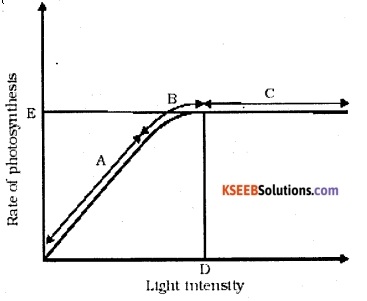
(a) At which point/s (A, B or C) in the curve is light a limiting factor?
Answer:
Generally, light is not a limiting factor. It becomes a limiting factor for plants growing in shade or under tree canopies. In the given graph, light is a limiting factor at the point where photosynthesis is the minimum. The least value for photosynthesis is in region 4. Hence, light is a limiting factor in this region.
(b) What could be the limiting factor/s in region A?
Answer:
Ught is a limiting factor in region A water, temperature, and the concentration of carbon dioxide can also be limiting factors in this region
do C and D represent on the curve (c) What
Answer:
D represents the optimum point and gives the light intensity at which the maximum photosynthesis is recorded. The rate of photosynthesis remains constant after this point, even though the intensity of light increases in region C.
Question 9.
Give comparison between the following:
(a) C2 and C4 pathways
Answer:
| C3 pathway | C4 pathway |
| (1) The primary acceptor of CO2 is RUBP – a five-carbon compound | The primary acceptor of CO2 is phosphoenolpyruvate a three-carbon compound. |
| (2) The first stable product is 3 – phosphoglycerate |
The first- stable product is oxaloacetic acid |
| (3) It occurs only in the mesophyll cells of the leaves | It occurs in the mesophyll and bundle sheath cells of leaves |
| (4) It is a slow process of carbon fixation and photo-respiratory losses are high | It is a faster process of carbon fixation and photo-respiratory losses are low |
(b) Cyclic and non-cyclic photophosphorylation
Answer:
| Cylic photophosphorylation | Non- Cylic photophosphorylation |
| (1) It occurs only in photosystem I | It occurs in photosystem I and II |
| (2) It involves only the synthesis of ATP | It involves the synthesis of ATP and NADPH2 |
| (3) In this process, photolysis of water does not occur. Therefore, oxygen is not produced | In this process, photolysis of water takes place and oxygen is liberated |
| (4) In this process, electrons move in a closed circle | In this process, electrons do not move in a closed circle. |
(c) Anatomy of leaf in C3 and C4 plants
Answer:
| C3 leaf | C4 leaf |
| (1) Bundle-sheath cells are absent | Bundle-sheath cells are present |
| (2) RuBisCo is Present in the mesophyll cells | RubisCo is present in the bundle sheath cells |
| (3) The first stable compound producted is 3- phosphoglycerate a three-carbon compound | The first stable compound producted is oxaloacetic acid – a four -carbon compound |
| (4) photorespiration occurs | photorespiration does not occurs |
1st PUC Biology Photosynthesis in Higher Plants Additional Questions and Answers
1st PUC Biology Photosynthesis in Higher Plants One Mark Questions
Question 1.
What is the name of the green plastid?
Answer:
Chloroplast (Oct. 83)
Question 2.
Where does oxygen liberated during photosynthesis come from? (Oct. 90)
Answer:
Water
Question 3.
What is the starting substance in the CO2 fixation cycle? (Apr. 91)
Answer:
RuMP.
Question 4.
Who proposed the Law of Limiting Factors?
Answer:
F.F. Blackman (Apr. 1991,1999)
Question 5.
In which reaction of photosynthesis oxygen is released? (Oct. 1994)
Answer:
Photolysis of water
Question 6.
What type of light causes maximum photo-synthesis? (Oct. 1995)
Answer:
Red light
Question 7.
What are Quantasomes? (Apr. 1997)
Answer:
Quantasomes is a functional unit (photosynthetic units) made of a group of pigment molecules required for carrying out a photochemical reaction.
![]()
Question 8.
Define Photophosphorylation. (Oct. 1997, Apr. 2000)
Answer:
Synthesis of ATP in the presence of light is called Photophosphorylation.
Question 9.
What is a C3 plant? (M.Q.P.)
Answer:
A C3 plant is one in which the first stable compound obtained during the dark reaction is a three-carbon compound.
Question 10.
Define photolysis of water. (Oct. 1998, 2000, M.Q.P.)
Answer:
Photolysis or photoionization is the splitting of water into protons, electrons and oxygen in presence of light.
Question 11.
What is phosphorylation? (M.Q.P.)
Answer:
Synthesis of ATP either with the help of light (during photosynthesis) or in presence of oxygen (during respiration) is called phosphorylation.
Question 12.
Name the first stable product of Calvin cycle. ; (Oct. 2003, July 2007, 2009)
Answer:
PGA – Phosphoglyceric Acid.
Question 13.
What is CAM pathway?
Answer:
The fixation of CO2 obtained from organic acid like malic acid in members of family Crassulaceae is called CAM pathway.
Question 14.
What are C4 plants?
Answer:
The plants produce 4 – carbon compounds as first stable substances during dark reaction are called C4 plants.
Question 15.
Expand NADP. (April 2004)
Answer:
Nicotinamide Adenine Dinucleotide Phosphate.
Question 16.
CAM plants close their stomata during day time. Give reason. (April 2007)
Answer:
These plants are mainly xerophytes which open their stomata at night when temperatures are low and close stomata during day time when temperatures are high as a mechanism to conserve water.
Question 17.
Give reason for the following
Some bacteria exhibit photosynthesis but they do not produce oxygen. (July 2006)
Answer:
Some photosynthetic bacteria do not use water as their source of hydrogen, hence do not liberate oxygen.
![]()
Question 18.
Give reason: (March 2008)
Very high temperature decreases the rate of photosynthesis.
Answer:
Chlorophyll undergoes photo-oxidation/ solarization at high temperature reducing photosynthesis.
Question 19.
Give reason: (July 2008, April 2009)
Carotenoid and Xanthophyli are called accessory photosynthetic pigments.
Answer:
Carotenoid and Xanthophyli transfer the absorbed light to chlorophyll ‘a1, hence are called accessory pigments. They cannot release electrons on their own and require chlorophyll.
1st PUC Biology Photosynthesis in Higher Plants Two Marks Questions
Question 1.
Write any two differences between Light and Dark reactions of Photosynthesis. (Mar. 1988)
Answer:
(i) Light reaction – (a) Dark reaction
- Takes place in presence of light.
(a) Independent of Light. - Mainly Photolysis and ATP synthesis with O4 evolution.
(b) Mainly concerned with carbon fixation.
Question 2.
What is quantasomes? (Oct. 94)
Answer:
Quantasome is a functional unit (Photo-synthetic unit) made of a group of pigment molecules required for carrying out a photochemical reaction. The Pigment molecules are embedded in the grana and differentiated as pigment system I (with chi 670, chi 680, P 700) and pigment system ll(with chi 670, chi 680, P 680 and Xanthophylls)
Question 3.
Mention the stages of light reaction. (M.Q.P.)
Answer:
The stages of light reaction are;
- Photoexcitation of chlorophyll
- Photolysis of water
- Photophosphorylation
- Reduction of NADP
Question 4.
Distinguish between cyclic and non-cyclic photophosphorylation. (M.Q.P., March 2011)
Answer:
(i) Non cyclic photophosphorylation (a) Cyclic photophosphorylation
- Path traversed by electron is non-cyclic.
(a) Path traversed by electron is cyclic. - Both PSI and PSII are active.
(b) Only PSI is active. - It is accompanied by photolysis.
(c) No photolysis. - Major pathway that takes place.
(d) Secondary pathway when additional ATP is needed.
Question 5.
Mention any two differences between Photosystem I and Photosystem II. (Oct. 1999)
Answer:
(i) Photosystem I – (a) Photosystem II
- Reaction centre is P 700 and absorbs red light of 700 nm efficiently.
(a) Reaction centre is P680 and absorbs light of 680 nm efficiently. - Located on the unstacked stroma thylakoids and regions of grana facing the stroma.
(b) Located mostly on the stacked membranes of the thylakoids
Question 6.
Define Blackman’s law of limiting factors. (Apr. 2000, Oct. 2002)
Answer:
When “a process is conditioned as to its rapidity by a number of separate factors, the rate of the process is limited by the pace of the slowest factor”.
Question 7.
What is reaction centre ? Give the reaction centres of PSI and PSII.
Answer:
Reaction centre is a chlorophylla component of photosystem and it absorbs as well as accepts energy from other pigments and ejects an electron.
The reaction centre of PSII is Chla680 or P680 and PSI is Chla700 or P700
Question 8.
List out any two differences between photo-phosphorylation and oxidative phosphorylation. (Apr. 2003)
Answer:
- Photophosphorylation takes place in the presence of light, whereas Oxidative phosphorylation takes place in the presence of oxygen.
- Photophosphorylation occurs in the chloroplast during photosynthesis, whereas Oxidative occurs in the mitochondria during respiration.
Question 9.
What is C4 -pathway? Give an example. (March 2008)
Answer:
CA -pathway is an alternative photosynthetic pathway seen in plants like sugarcane/sorghum/ maize in which the1ststable compound is oxaloacetate a 4-C compound. It is called Hatch-slack pathway.
Question 10.
Draw a neat labelled diagram of ultrastructure of T.S. of chloroplast. (March 2008)
Answer:
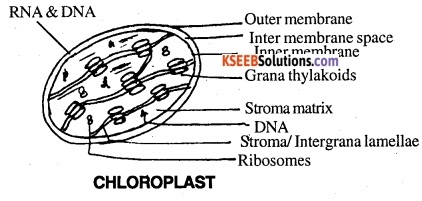
Chloroplast are lens shaped cell organelles located in the mesophyll cells. The chloroplast is bounded by a double membrane separated by the intermembrane space. The centre encloses a homogeneous gel-like fluid called stoma or matrix. It has 50% of the chloroplast proteins, Ribosomes, DNA and enzymes of dark reaction.
The matrix has a system of lamellae differentiated as grana lamellae made of flattened sacs called thylakoids arranged as a stack of coins. The thylakoid membrane has an outer stromal surface and an inner luminal surface in contact with the thylakoid lumen. Some of the lamellae are unstacked and connect the grana called stroma lamellae or inter grana lamellae. The grana lamellae form the site for light reaction and stroma form the site for a dark reaction.
1st PUC Biology Photosynthesis in Higher Plants Five Mark Questions
Question 1.
Define Photosynthesis and explain the light reaction of Photosynthesis.
(Apr. 1983, 1987, 1993, 1995, 1997, 1999, 2006, Oct. 1985, 1991, 1992, M.Q.P.)
Answer:
Photosynthesis is defined as the process in which carbohydrates are synthesised from CO2 and H2O by green plants using radiant energy of the sun, O2 being a byproduct.
Light Reaction: Also called Photochemical reaction and is light-dependent.
Light reaction can be summarized in 4 steps;
- Photoexcitation of chlorophyll
- Photolysis of water
- Photophosphorylation
- Photoreduction of NADP
Photoexcitation of chlorophyll: When a chlorophyll molecule is exposed to light it absorbs radiant energy and the electron in its structure picks up energy and becomes a high energy electron. The energy moves rapidly through the light-harvesting pigment molecules to reach trie reaction centre.
It causes an electron to acquire a large amount of energy and escapes from the reaction centre leaving the chlorophyll with a net positive charge.
Photolysis or Photoionisation of water:
The source of Oxygen was earlier thought to be CO2 but by the work of Van Neil, Ruben and Kamen using O18 it was proved that it comes from H2O.
Water splits up in the Manganese containing Oxygen evolving complex under the influence of light to produce protons, electrons, oxygen and water. The overall equation is represented as
\(2{ H }_{ 2 }o\rightarrow 4{ H }_{ 2 }^{ + }+4{ e }^{ – }+{ O }_{ 2 }\)Theoretically, 8 quanta of light are required to produce one molecule of oxygen from water.
Photophosphorylation: It is the process by which ATP is synthesised in the presence of light. It was first discovered by Arnon. The process is further differentiated into cyclic and non-cyclic depending on the path taken by the electron. In cyclic the path traversed is cyclic and in non-cyclic, the path traversed is non-cyclic.
Non-cyclic Photophosphorylation:
Non-cyclic Photophosphorylation is initiated by the absorption of a photon of light by PS 11 whose reaction centre is P680 and results in the ejection of an electron creating a hole. The ejected electron is trapped by pheophytin, passes to plastoquinone (PQ) and then takes a downhill path along electron carriers cyt b6 cyt f and plastocyanin and reaches PSI with reaction centre P700.
Absorption of light by PSI now causes the ejection of the electron released from PSII which is trapped by FRS moves to Ferredoxin and using the protons released by photolysis NADP is reduced to NADPH2.
The hole created in PSII due to loss of the electron is filled by electrons produced during photolysis. Photolysis is aided by the Mn-containing oxygen-evolving complex. The path of electrons is from water to PSII, PSII to PSI and PSI to NADP in zig-zag manner called pathway.
In non-cyclic photophosphorylation, the ejected electron does not come back to PSII hence the path is non-cyclic, ATP is synthesised between cyt b6 and cyt f, photolysis takes place and photoreduction of NADP to NADPH2 takes place. (July 2006)
Cyclic Photophosphorylation:
Cyclic Photophosphorylation occurs when additional ATP molecules are required and is a supplementary process. Only PSI with reaction centre P700 is activated. The ejected electron of PSI is captured by Ferredoxin and cycled back through a series of electron carriers cyt b6, cyt f and plastocyanin. During the downhill jour
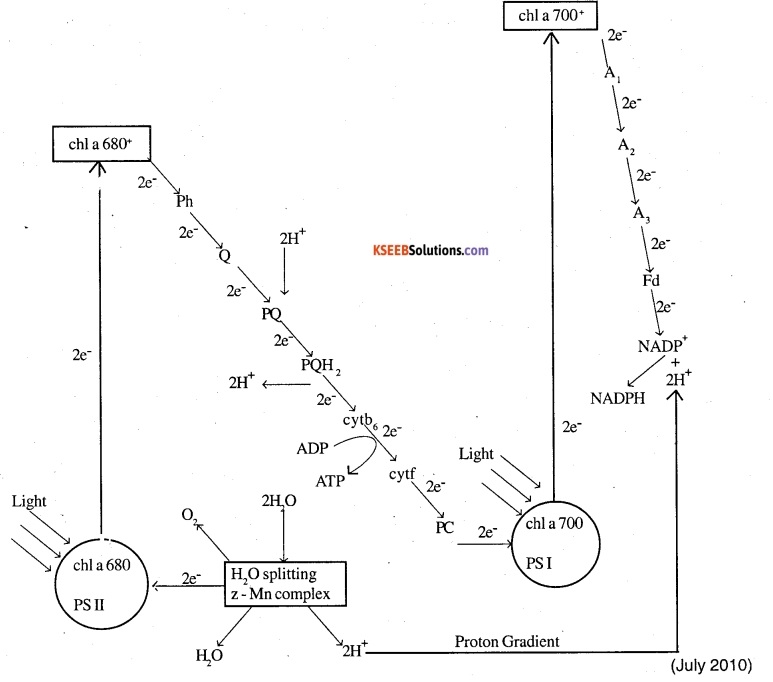
A schematic diagram of the Non cyclic photophosphorylation and Non cyclic ETS. Abbrevations: Ph = Pheophytin, Q = Quinone, PQ = Plastoquinone, PQH2 = Plastohydro quinone, cytb6 = Cytochrome b6, cytb6= Cytochrome f, PC = Plastocyanin, A1, A2, A3 = electron acceptors of PSI, Fd.= Ferridoxin, NADP = Nicotinamide adenine dinucleotide phosphate.
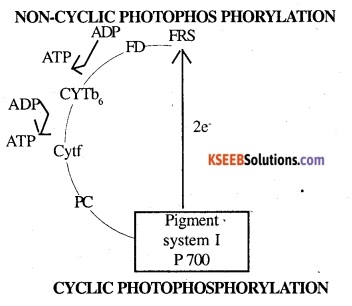
ney of electron; free energy is utilised for ATP synthesis at 2 places i.e., between ferredoxin and cyt b6 and cyt b6 and cyt f. The process does not require photolysis of water and NADPH2 formation.
Photoreduction of NADP:
This takes place during non cyclic Photoohosphorylation and NADPH2 is an excellent reducing agent. ATP and NADPH2 are called the assimilatory powers which are utilised during the dark reaction.
![]()
Question 2.
Draw labelled diagrams and describe the structure and functions of chloroplast.
(Apr. 1983, Oct. 2001, April 2004, 2006, March 2011)
Answer:
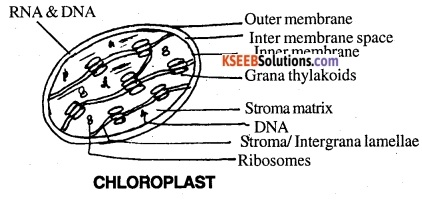
Chloroplast are lens shaped cell organelles located in the mesophyll cells. The chloroplast is bounded by a double membrane separated by the intermembrane space. The centre encloses a homogeneous gel-like fluid called stoma or matrix. It has 50% of the chloroplast proteins, Ribosomes, DNA and enzymes of dark reaction.
The matrix has a system of lamellae differentiated as grana lamellae made of flattened sacs called thylakoids arranged as a stack of coins. The thylakoid membrane has an outer stromal surface and an inner luminal surface in contact with the thylakoid lumen. Some of the lamellae are unstacked and connect the grana called stroma lamellae or inter grana lamellae. The grana lamellae form the site for light reaction and stroma form the site for a dark reaction.
Question 3.
Explain Calvin cycle of photosynthesis.
OR
Describe the essential steps of dark reaction of photosynthesis. (April 84, 94, 96, 98, 03, Oct. 84, 90, 2001)
OR
Give the schematic representation of Calvin cycle. (March 2009, 2010)
Write the schematic representation of C3-pathway. (July 2011)
Answer:
Calvins cycle or dark reaction or C3 cycle or thermochemical reaction forms the second step of photosynthesis which takes place independent of light. The steps involved here studied by Calvin using C14.
Dark reaction mainly includes the fixation of carbon to produce the carbohydrate. This occurs in the stroma and utilises the assimilatory powers produced during the light reaction.
The steps involved may be summarised as follows.
(1) First Phosphorylation: The starting compound RuMP(Ribulose Mono Phosphate) is converted to RuBP(Ribulose biphosphate) utilising 6 molecules of ATP from the light reaction. 6 molecules of RuBP are obtained from 6 molecules of RuMP.
(2) Carbon fixation by RUBP: The CO2 is accepted by RuBP the primary acceptor to give 12 molecules of PGA(phosphoglycerate) a 3-carbon compound; The 6-carbon compound is highly unstable and dissociates to form the 3-carbon compound.
(3) Second Phosphorylation: The 12 molecules of PGA utilise 12 ATP molecules to yield 12 Di PGA. The ATP used is produced during the light reaction.
(4) Reduction: 12 Di PGA combine with NADPH2 of the light reaction and are reduced to 12 PGAL(phosphoglyceraldehyde) a-3-carbon compound. The other products are 12iP, 12NADP and H2O.
Out of the 12 PGAL molecules only 2 are transported to the cytoplasm and used for the formation of a sugar molecule (hexose) and the remaining two molecules are used to regenerate RuBP.
Synthesis of sugar involves condensation of 2PGAL to give fructose 1-6-diphosphate which by dephosphorylation forms Fructose 6-Phosphate and by isomerization forms, glucose and finally is stored as sucrose.
Regeneration of RuBP involves the formation of intermediates like Erythrose monophosphate, xylulose monophosphate, Sedoheptulose monophosphate, Ribose monophosphate and finally Ribulose monophosphate-RuMP which gives RuBP.
The overall equation of dark reaction is
![]()
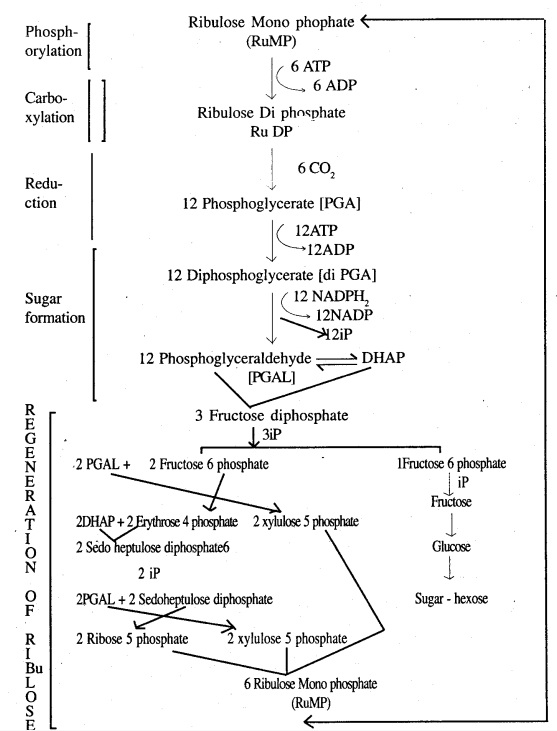
Question 4.
Describe the factors that influence the rate of Photosynthesis. (Oct. 1989)
Answer:
The factors that affect photosynthesis may be both internal & External.
Internal factors:
- Chlorophyll: it is the light-absorbing pigment and only portions of the plant having chlorophyll can help in photosynthesis.
- Protoplasmic factor: young seedlings when transferred from darkness to light show the presence of some factors which is believed to be enzymatic initiates photosynthesis and is called protoplasmic factor.
External factors:
- Light: It is one of the most important factors which affects the process in 3 ways i.e. quantity, quality and intensity. Quantity of light is otherwise duration and depends upon the photoperiod that is required by the plant quality refers to the wavelength, maximum photosynthesis occurs in red and blue light while minimum in green light. Intensity favours the process and low intensity decreases the rate of photosynthesis. Very high intensity brings about photooxidation of pigments which is called solarization.
- CO2: An increase in CO2 concentration favours the process provided other factors are not limiting but very high concentrations are toxic and inhibit photosynthesis.
- Temperature: Increase in temperature favour photosynthesis but above the optimum range the process decreases due to denaturation of enzymes.
Question 5.
Schematically explain non-cyclic photophosphorylation. (Apr. 2002,2007)
Answer:
Non-cyclic photophosphorylation is the ATP synthesis in the presence of light following a non- cyclic pathway. It requires both PSI and PSII+ work in sequence and are linked by electron carriers of the electron transport system. The path of electrons is from H2O to PSII, PSII to PSI and PSI to NADP.
When a photon of light is absorbed by PSII its electron is boosted to a high energy level P680* and transferred to pheophytin which acts as the primary electron acceptor. The electron is then transferred to quinone on the stromal surface of the thylokoid membrane which by accepting a second electron and 2H+ from stroma forms H2. The H2 dissociates releasing 2e– on the luminal side to cyt b complex and 2H+ to the lumen to add to the proton pool. Electrons released by cyt b/f complex move to PC which diffuses through the lumen to P700 of PSI.
The PSI is now activated and the electron from PSII is boosted to P700* and is passed along A0, A1, Fx,Fab and is transferred to Fd on the stromal surface and gets reduced. Reduced ferredoxin transfers its electrons to NADP+ which absorbs 2e- and H+ from stroma to produce NADPH and 1. excellent reducing agent by photoreduction. The electron gap formed in P680* is filled by electrons produced by photolysis through OEC.
The electron flow is non-cyclic, H2 is used to produce NADPH, ATP is formed from ADP, O2 from H2O and water.
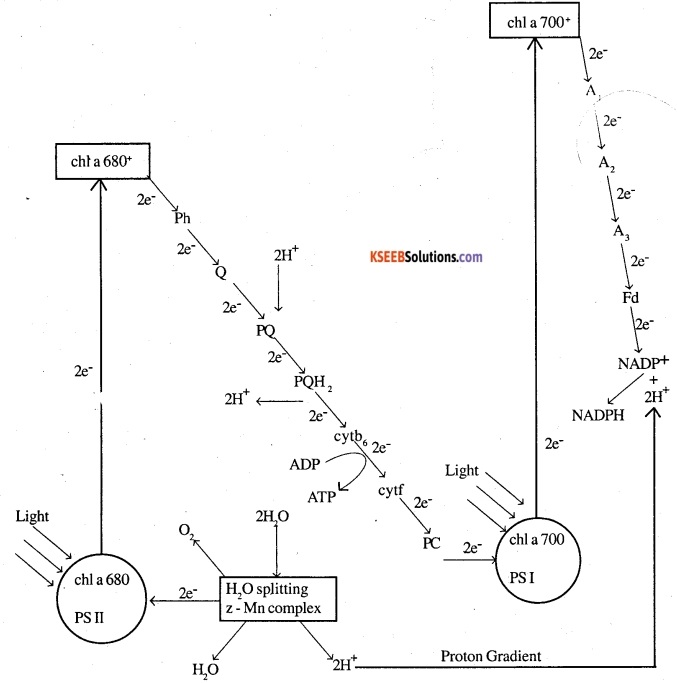
A schematic diagram of the Non cyclic photophosphorylation and Non cyclic ETS. Abbrevations : Ph = Pheophytin, Q = Quinone, PQ = Plastoquinone, PQH2 = Plastohydro quinone, cytb6 = Cytochrome b6, cyt f = Cytochrome f, PC = Plastocyanin, A1, A2, A3 = electron acceptors of PSI, Fd = Ferridoxin, NADP = Nicotinamide adenine dinucleotide phosphate.
![]()
Question 6.
Explain Photoexcitation and photolysis.
Answer:
Absorption of light energy and ejection of electrons by the chlorophyll is called phoexcitation. The chlorophyll and accessory pigments of LHC of both PSI and PSII absorb radiant energy in the form of photons and transfer their absorbed energy to the reaction centre. The reaction centre of PSI and PSII gets excited and ejects its outer valance electron and the chlorophyll becomes oxidized. The electron given out by the chlorophyll is accepted by electron carrier molecule of each photosystem. So by giving out an electron, chlorophyll becomes oxidized and electron carrier molecule is reduced. The electron escaped from the excited chlorophyll is high energy electron, so that it carries a lot of energy.
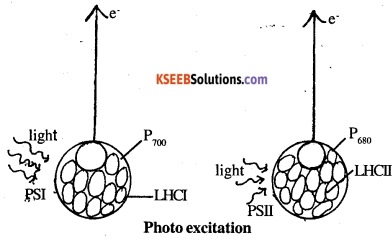
Photolysis of water (Photo oxidation of H2O) Lysis of water into a proton (H+), electrons (e ) and molecular O2 in the presence of light is called photolysis of water. Water by donating electron becomes oxidized.

When light falls on PSII, its reaction centre (Chla680) gets excited by ejecting an electron. Water splits in the Mn2+ associated Z – protein-containing oxygen-evolving complex under the influence of the light entering photosystem II. The protons (H+) released into the thylakoid lumen, electrons (e–) are used to fill a gap created in P680 and molecular O2 is released.
Question 7.
Write a note on photosynthetic pigments.
Answer:
The pigments which they absorb light during photosynthesis are called photosynthetic pigments. They are,
(1) Chlorophyll: Chlorophyll pigments are of various types. Chlorophyll a, b, c, d, e, bacteriochlorophyll etc.
Chlorophyll:
It is the primary photosynthetic pigment. The chemical formula of chlorophyll is C55H72O5N4Mg. It contains a methyl group (CH3). Chlorophyll is called primary photosynthetic pigment because it not only absorbs light but it converts absorbed light energy into chemical energy. Chi a absorbs red light and blue light.
(2) Accessory pigments: The pigments absorb certain wavelengths of light and they pass that absorbed energy to chi a (primary photosynthetic pigment). They do not convert absorbed energy into chemical energy. The transfer of absorbed energy to chi a is called resonance transfer. Chlorophyll b and carotenoids are the accessory pigments.
(3) Chlorophyll: It is an accessory pigment and its formula is C55H70O6N4Mg. It differs from chi a in having aldehyde group (CHO). It absorbs red light of 644nm and blue light of 455nm. It transfers absorbed light energy to chla.
(4) Carotenoids:
They are accessory pigments, they are of two types – carotenes (orange) and Xanthophylls (yellow) carotenes are insoluble in water and soluble in organic solvents. Carotenoids are always found associated with chlorophylls and in thylakoids they are present as chromoproteins. Carotenes absorb blue and green lights and transmit red and yellow lights. Carotenoids absorb light of visible spectrum between 450 – 500nm. The formula of carotene is C40H56 (Carotene is hydrocarbon compound). The formula of Xanthophyll is C40H56O2N4
Question 8.
Describe Mohl’s half leaf experiment. (April 2006)
Answer:
Aim: To show that CO2 is necessary for photosynthesis.
Procedure: A potted plant is placed in the dark for 2 days to destarch it completely. To one of its leaf a wide-mouthed bottle with a split cork is fixed in such a way that half the leaf is inside the bottle and the other half outside the bottle. The bottle contains KOH solution. The set up is placed under sunlight for a few hours, the leaf detached and tested for starch.
Result: The leaf shows a lower portion dark blue in colour and upper part light in colour.
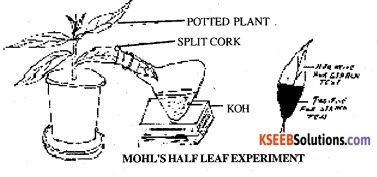
Inference: CO2 is one of the raw materials of photosynthesis. It is needed to produce carbohydrate. The portion of the leaf inside the bottle does not receive CO2 hence gives a negative test for starch, but the lower portion which is outside the bottle receives CO2 hence gives a positive test. The equation of photosynthesis is
![]()
Question 9.
Explain the fixation of carbon dioxide during the C3 pathway.
Answer:
The photosynthetic reaction which does not require light (light-independent) is called dark reaction. A dark reaction occurs in the stroma portion of chloroplast so it is called stroma reaction. It is also called Blackman’s reaction. Dark reaction is influenced by temperature. The different chemical reactions of dark reaction are enzymatic. Enzymes of stroma catalyze these reactions. Enzymatic reactions of dark reaction occur in the form of a Cycle and they were studied by Melvin Calvin, Benson and Bassham in 1949.
So dark reaction is also called Calvin cycle or Calvin Benson cycle. They used tracer technique by using C14O2 in unicellular alga Chlorella and found a path of CO2 in each step of a chemical reaction. The ATP and NADPH of light reaction are used for the fixation of CO2 during the dark reaction. The main event of dark reaction is the fixation of CO2. So dark reaction is also called CO2 fixation cycle.
![]()
The end product of calvin cycle or dark reaction is hexose sugar (glucose).
CO2 acceptor compound: CO2 diffuses into the mesophyll tissue through stomata and then into stroma of chloroplast. CO2 is first accepted by a 5 – carbon compound called Ribulose 1, 5 biphosphate (RUBP). So RUBP is CO2 acceptor compound during dark reaction. RUBP is first available in the form of RUMP (Ribulose monophosphate).
First stable intermediate compound of dark reaction: During dark reaction, the first stable intermediate compound formed is phosphoric- eric acid and it is 3 – carbon compound. So dark reaction studied by Calvin (Calvin cycle) is called C3 cycle. The plants which produce 3 carbon compound (phosphoglyceric acid – PGA) as their first stable product are called C3 plants.
The various steps of C3 cycle are:
(1) Phosphorylation: 6 molecules of RUMP (Ribulose monophosphate) reacts with 6 mol-ecules of ATP and produce 6 molecules of RUBP (Ribulose 1,5 biphosphate) which is CO2 acceptor compound.
(2) Carboxylatlon: Six molecules of CO2 react with 6 molecules of RUBP in the presence of an enzyme RUBP carboxylase oxygenase or “Rubisco”. RUBP is converted into 12 molecules unstable 6 carbon compound.
(3) Cleavage (Splitting): 12 mole of 6 carbon unstable compound splits into 12 molecules of 3 carbon compounds called phosphoglyceric acid (PGA). Since PGA (Phosphoglyceric acid) is 3 carbon compound and it is first stable intermediate product of calvin cycle. So it is C3 cycle.
(4) Phosphorylation: 12 molecules of PGA are phosphorylated in presence of 12 ATP molecules to 12 molecules of 1,3 ‘ diphosphogly ceric acid (12diPGA)

(5) Reduction: 12 molecules of 1,3 diphosphoglyceric acid is reduced to form 12 molecules of 3 – phosphoglyceraldehyde (PG AL) by 12 molecules of NADPH, produced in the light reaction.
12 mols, 1,3-di PGA+ 12 NADPH

(6) Utilization of PGALD for the synthesis of sugar and the regeneration of RUMP.
(A) Out of 12 PGAL, 5 PGAL are isomerized to 5 molecules of dihydroxyacetone phosphate (DHAP).
![]()
(B) 3 PGAL undergo condensation with 3 DHAP to form 3 molecules of 6 carbon compound 3 Fructose 1,6 diphosphate (3 F.1,6 diphosphate)
![]()
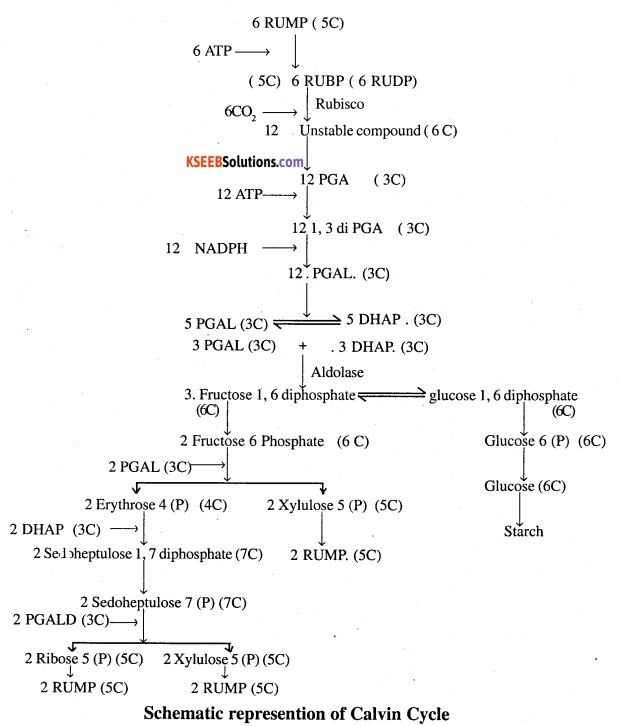
Question 2.
Explain the structure of ATP and write three types of ATP synthesis.
Answer:

Adenosine triphosphate has three components
(a) Adenine (a nitrogen base)
(b) ribose sugar c) three inorganic phosphate.
Adenine + ribose → Adenosine
Adenosine + 3 Pi → Adenosine + triphosphate
ATP can be written as A – (P) ~ (P) ~ (P).
The first phosphate which is linked by an ester linkage to ribose. The two-terminal bonds are energy-rich and first bond is energy poor. The energy-rich phosphate bonds are represented by a curly line (~) and energy-poor bond by a straight line (-).
ATP is synthesized by the addition of inorganic phosphate to ADP. This process is
Ceiled phosphorylation.
n ADP + n Pi → n ATP.
There are three different types of phosphorylations.
- Photophosphorylation.
- Oxidative phosphorylation.
- Substrate level phosphorylation.